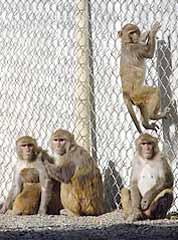Since the discovery of the AIDS virus in these monkeys, the demand for them has exceeded the supply; Animal rights groups are outraged by the increase in the use of monkeys for experiments
"Haaretz" service, news and voila!

Spray monkeys. The AIDS virus was first discovered in a monkey population in California
A deserted plot of land, surrounded by highways and trucks, does not seem at first glance to be the ideal area for raising monkeys. However, in this place, the National Monkey Research Center in California, scientists discovered for the first time, 20 years ago, a virus that caused the extinction of the rhesus monkey population there. This virus developed further into the AIDS virus.
The discovery of the virus among the monkey population marked a milestone in scientific research that resulted in a considerable increase in the demand for the spray monkeys. The demand for monkeys remains high even today, when scientists experiment with them to study the SARS, Ebola viruses and biochemical threats such as anthrax and ricin.
However, the current supply of spraying monkeys does not meet the demand for them. An Indian ban on the export of monkeys, the destruction of monkey breeding areas around the world and low reproduction have led to a continuous decline in the monkey population. Thus, the price of one rhesus monkey rose to 5,000 to 12 dollars in 2003 compared to about 1,000 dollars in 1990.
The issue is more complex, due to the opposition of animal rights organizations to the use of monkeys for research. According to them, the scientists use intimidation to secure government research grants. Thus, the scientists' grants were increased this year by 1.4 billion dollars, intended for the research of biochemical threats.
On the other hand, the scientists claim that the use of monkeys is only carried out when they have no alternatives. According to them, the lack of monkeys made them postpone important studies and use animals in more than one experiment, in a way that could damage the reliability of the results.
Starting this year, the American government will spend 100 million dollars to expand and improve the breeding centers of the rhesus macaques. But the results of this investment will be seen only in a few years because the reproduction of rhesus monkeys is extremely slow.
At the same time, the American Center for Research Resources found places to breed monkeys in foreign countries, including in Puerto Rico and Tingle Island. According to animal rights activists, the research bodies breed monkeys overseas to circumvent American restrictions on breeding animals for experiments. These organizations see the expansion of baboon breeding as a degradation after they succeeded in reducing the scope of baboon and chimpanzee breeding.
"We must reach a decrease in the use of monkeys for research, and not an increase in it," says Kathleen Conley, from the American Animal Welfare Organization, "Our main claim is that not enough attempts are being made to find alternatives."
https://www.hayadan.org.il/BuildaGate4/general2/data_card.php?Cat=~~~815017583~~~32&SiteName=hayadan
